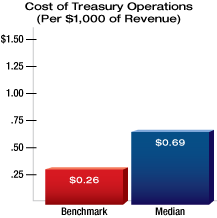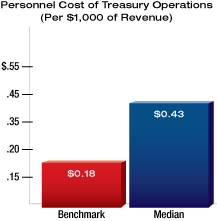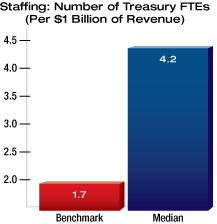|
Large gaps between the performance of typical treasury organizations and world-class treasury units suggest there are opportunities for many organizations to improve their treasury operations, according to researchers at the Association for Financial Professionals (AFP).
This conclusion was drawn based on results of the 2009 AFP Treasury Benchmarking Program survey, the second in a series of three planned annual surveys being conducted by the AFP in partnership with IBM and underwritten by Deutsche Bank.
"One of the consistent results across both the 2008 and 2009 surveys is a fairly pronounced gap between median and benchmark performance," says Jeff Glenzer, a Managing Director at the AFP.
The benchmark (or high-performance) standard is based on 80th percentile responses. In areas ranging from cost of treasury operations to staffing levels, there is a wide difference between median and benchmark performance levels throughout the 2009 survey results, very similar to the results in 2008, Glenzer says.
One of the goals of the 2009 survey, he says, was to begin identifying what's driving these gaps. In particular, the survey asked questions to gauge the extent to which automation and treasury structure (e.g., centralized vs. decentralized) are driving performance differences.
Here's a look at some of the more noteworthy benchmarking survey findings:
Treasury Operating Costs
 Based on the 2009 survey results, the magnitude of the benchmark gap (benchmark compared to the median) is significant for virtually all cost and resource benchmarks.
Based on the 2009 survey results, the magnitude of the benchmark gap (benchmark compared to the median) is significant for virtually all cost and resource benchmarks.
The typical (median) organization operates its treasury operations at an average cost of 69 cents per $1,000 of annual revenue, while the benchmark standard was 26 cents per $1,000 of revenue — a gap of 43 cents per $1,000.
The vast majority of treasury resources (72%) are spent on personnel, according to the survey. The typical organization spends 43 cents per $1,000 in annual revenues on treasury personnel costs. However, the benchmark organization only spends 18 cents per $1,000.
"There again we see a huge performance gap, which is consistent across revenue size, industry and region," says Kevin Roth, Managing Director, Research, at the AFP.
Two other notable survey findings regarding treasury costs were:

- Size matters. The smaller an organization is, the more intensive its investment in treasury operations tends to be relative to revenue. The typical organization with annual revenues between $6 billion and $10 billion spends 29 cents per $1,000 of annual revenue, compared to $1.50 per $1,000 in revenue for the typical organization with between $100 million and $499 million in revenue.
- Industry matters, too. Financial services organizations tend to incur the highest level of costs. This is likely due to their regulatory requirements and strategic emphasis on cash management. "For a manufacturing company, cash and risk management are by-products of their business," Glenzer explains. "In the finance and insurance industries, those disciplines are their business."
Staffing
The benchmark gap is also evident in responses related to staffing. The typical organization has 4.2 full-time equivalent employees (FTEs) for every $1 billion in annual revenues, compared to 1.7 FTEs for every $1 billion in revenues for a benchmark organization. 
The number of FTEs in treasury differs on a normalized basis by organization size. As an example, the typical organization with annual revenues between $6 billion and $10 billion has 1.6 FTEs per $1 billion of annual revenue, while those with annual revenues between $500 million and $999 million utilize 5.5 FTEs, according to the survey results.
Treasury staffing levels also differ greatly by industry type. Organizations in the finance/insurance industry employ the most FTEs on average — 10.0 per $1 billion in annual revenues — followed by government (8.0), services (5.5), information/communications (5.4), manufacturing (3.1) and energy (2.0).
Personnel costs average $100,000 per treasury operations FTE, including compensation and benefits. Size has an impact here, as well. Organizations with annual revenues between $6 billion and $10 billion spend an average of $105,800 per treasury operations FTE, compared to $92,100 at organizations with annual revenues between $500 million and $999 million.
Continue article
Here’s what’s ahead:
• Cycle Times
• Organizational Structure
• Automation
• European Results
• Looking Ahead to the 2010 Survey |

